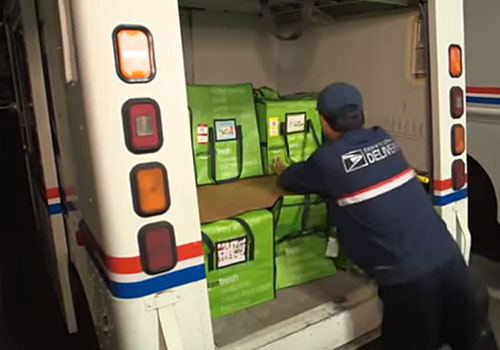
For the Post Office: Snow, rain and now gloom of recession
Neither snow nor rain nor heat nor gloom of night will keep your mail carrier from making the daily rounds, promises the U.S. Postal Service's unofficial motto — but the economy might. With 9.5 billion fewer letters and packages delivered in the 2008 fiscal year compared with 2007, the biggest mail volume decline in history has contributed to the agency's $2.8 billion loss for the year. That partly explains why shipping prices will rise 5% this month (a bigger hike than all shipping increases in 2008), with a stamp price jump to follow in May. The decline could also put your local letter carrier out of a job, and it has even stoked fears that the centuries-old Postal Service could one day go the way of the telegraph.
Mail deliveries, like hemlines, always drop in economic downturns. But the current pinch is worse than usual. One reason: the housing and financial sectors were once gold-star postal customers, but since their cash flows have slowed to a trickle, their direct-mail marketing campaigns have all but dried up. Mortgage direct mailings declined 57% from the first quarter of 2007 to the first quarter of 2008, according to the Chicago-based mail and advertising tracker Mintel Comperemedia. And credit card offers by mail sagged 28% from the third quarter of 2007 to the third quarter of 2008, dropping to their lowest point in more than three years.
The Postal Service had already been limping along, taking heat on several fronts. One of its biggest threats is e-mail, which has made the art of letter-writing seem downright quaint and last year contributed to a nearly 10% drop in first-class mail (that's individual letters to you and me), the worst loss in any mail category. Demand for deliveries has been further beaten down by environmentalists, who consider snail mail a waste of paper. Meanwhile, spikes in oil prices in 2008 drove operating costs for the Postal Service's fleet — which is 220,000 vehicles strong — through the roof. (Marking one financial bright spot, those surges have since subsided.) And perhaps most biting of all are the multiple billions of dollars the agency has had to dole out annually to a prepaid retiree health-benefit fund, which was created by the Postal Act of 2006. The overall picture isn't pretty. "We actually reached that tipping point, where —" says spokesman Greg Frey, before cutting himself off to be more blunt: "Last year was a bad year."
Although the Postal Service is a government agency, it lost taxpayer funding in 1982, which means that it now has to operate within the black like any private company. Even before last year's financial loss was announced, the Postal Service — knowing that bad tidings were on the way — had scrambled to find $2 billion in savings. In 2008 the agency cut 50 million work hours and phased out many of its 23,000 automated stamp vending machines, which have become expensive to repair and update. Clearly, the savings weren't enough. And 2009 doesn't look much better. "We expect the new fiscal year to be another difficult one for the Postal Service and the entire mailing industry," Postmaster General John Potter told the Postal Service Board of Governors at their meeting in November. Officials anticipate a further mail volume decrease of 8 billion pieces in 2009 — almost matching the 2008 plunge.
The agency's bleak outlook means the Postal Service will take more drastic steps. Some are primarily intended to attract more customers. Starting Jan. 18, for instance, online discounts and other savings plans begun in May 2008 will expand to make Postal Service prices more competitive — a move that could be showcased in a spring advertising campaign that will promote Priority Mail.
Other changes, however, could be more painful. The Postal Service has frozen officers' and executives' pay and cut back on travel. Unlike competitors FedEx and UPS, the agency is hoping to avoid shedding jobs. Still, since September, 156,000 employees at the nation's largest employer — from executives on down — have been offered voluntary early retirement. About 5% are expected to accept: a first wave of 3,685 workers effectively retired on Dec. 31, while about 4,000 more will exit in February. Several thousand more departures are expected in March. The retirees will not be replaced. These reductions are accelerating a trend: before they began, there were already 100,000 fewer postal workers than there were about seven years ago, with automated sorting technology picking up much of the slack. Meanwhile, part-time employees will be limited to working fewer hours, temp hiring will be cut back, and contract employees may be eliminated altogether.
If those measures aren't enough to stop the bleeding, deeper cuts could follow. "If the economy improves, maybe we won't have to be as aggressive," says Frey. "But if it seems to linger and we stay down in the recessionary trough here, who knows?"












